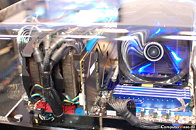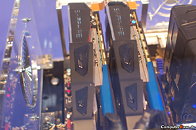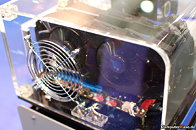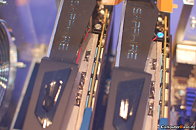- Joined
- Oct 9, 2007
- Messages
- 47,538 (7.47/day)
- Location
- Hyderabad, India
| System Name | RBMK-1000 |
|---|---|
| Processor | AMD Ryzen 7 5700G |
| Motherboard | ASUS ROG Strix B450-E Gaming |
| Cooling | DeepCool Gammax L240 V2 |
| Memory | 2x 8GB G.Skill Sniper X |
| Video Card(s) | Palit GeForce RTX 2080 SUPER GameRock |
| Storage | Western Digital Black NVMe 512GB |
| Display(s) | BenQ 1440p 60 Hz 27-inch |
| Case | Corsair Carbide 100R |
| Audio Device(s) | ASUS SupremeFX S1220A |
| Power Supply | Cooler Master MWE Gold 650W |
| Mouse | ASUS ROG Strix Impact |
| Keyboard | Gamdias Hermes E2 |
| Software | Windows 11 Pro |
The fact that Sapphire has been working on a Radeon HD 7970 graphics card with an obscene 6 GB of memory has been known since the end of 2011. The said card, the Sapphire Toxic HD 7970 6GB, has already taken shape, and was spotted running at CeBIT. Such as it is, AMD utilizes 2 Gbit GDDR5 memory chips in numbers of 12 to achieve 3 GB of memory across a 384-bit wide memory interface, on its HD 7970. Higher density GDDR5 chips are not available, at least not in bulk. So the only way Sapphire is doing 6 GB is by piggy-backing two 2 Gbit chips across 32-bit wide paths, each. As a result, these cards have memory chips on both sides of the PCB, obverse and reverse, and require a metal back-plate to keep the chips on the reverse side cool. The only reason we see consumers needing 6 GB of video memory today, is multi-monitor gaming. Even there, the impact of the increase to 6 GB memory (from 3 GB) is debatable.




View at TechPowerUp Main Site




View at TechPowerUp Main Site








 you must be playing some old games
you must be playing some old games 


